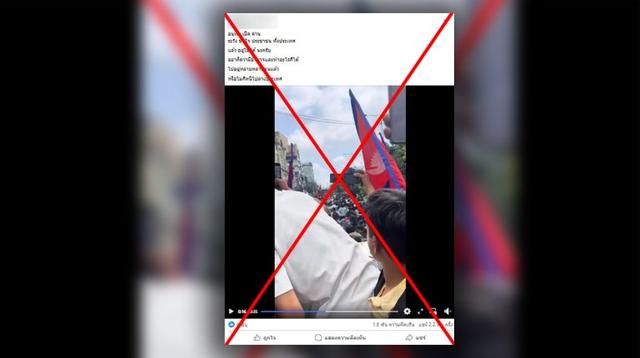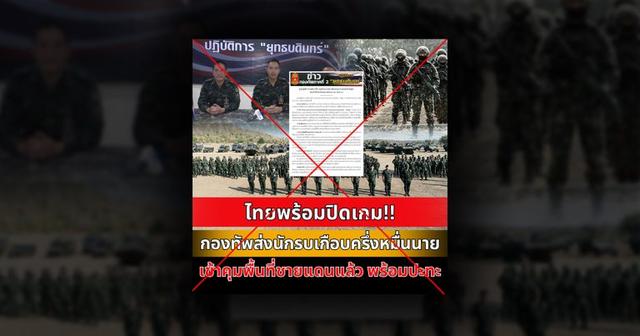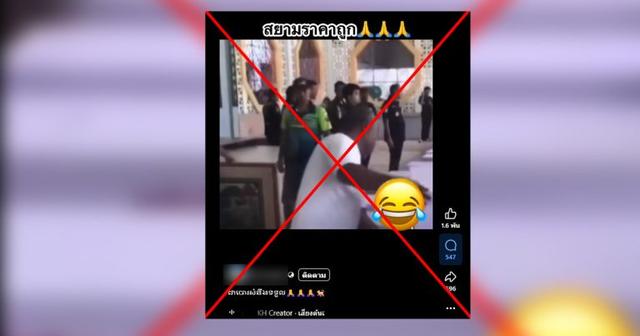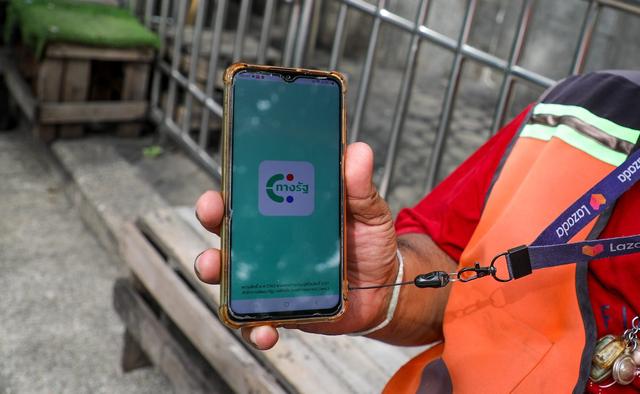Thai PBS Verify found the source on Facebook.

Screenshot showing the post claiming “Laos, Thailand, Vietnam” seized 62 provinces of Cambodia.
The Cambodian Facebook page named មេផ្ទះ Housewife posted a message stating that:
ខេត្តក្រុងខ្មែរដែលបាត់ពីជំនាន់មុនសរុប ៖
ឡាវ: ៦ខេត្ត
សៀម: ៣៦ខេត្ត ក្រុង១
វៀតណាម: ២០ខេត្ត ក្រុង១ កោះ២ កំពង់ផែ២ ប្រាសាទ១ កូនខ្មែរគួរចងចាំ
When translated into Thai, the said post was found to claim that:
Total provinces and cities of Khmer lost from previous generations:
1. Laos: 6 provinces
2. Siam (Thailand): 36 provinces, 1 city
3. Vietnam: 20 provinces, 1 city, 2 islands, 2 ports, 1 temple. Khmer children should remember.
The post in question was published on October 3, 2025, and has since received over 9,100 reactions and been shared more than 3,800 times.
History That Does Not Correspond With Reality
Thai PBS Verify investigated the said post with Dr. Yingyos Boonchan, a lecturer in the History Department, Faculty of Arts at Silpakorn University. He provided information concerning the case, according to the post, which he believes refers to the greatness of the Angkor period, corresponding to the era of King Jayavarman VII, during which records show which cities were once under Angkor’s authority. It was found that this power extended into areas of Thailand, such as Phetchaburi and Kanchanaburi, which were considered major cities within the scope of King Jayavarman VII’s authority. Therefore, he believes that the post employs this interpretation. Because, after the era of King Jayavarman VII, around the 11th-12th centuries, Cambodia’s power declined, and various territories began to separate and become independent. New political groups were established, such as those representing the Thai ethnic group or groups that were once under Khmer power, and they sought independence. This is the origin of the claim about the number of provinces Thailand took.

Dr. Yingyos Boonchan, a lecturer in the History Department, Faculty of Arts at Silpakorn University
As in the case of Vietnam, particularly in the city of Saigon, now known as Ho Chi Minh City, it was once under the administrative authority of Cambodia. However, around the 18th century, the Cambodian king was weak. Therefore, Vietnam took control of the area, governing it and acquiring the territory. Saigon was the administrative center of France during the period when it seized Indochina as a colony.
In the case of Laos, many areas were once under the authority of a culture that had Khmer influences, the traces of which can still be found, extending up to Champasak. Therefore, he thinks the said post is likely interpreted in the context of history, considering how large their territory once was and how it has since disappeared. This leads to the word ‘province’ being used, but in the past, there was no word ‘province’, and there was also no clear term for whose area it was. But the various regions would be seized according to the reign of any one king, depending on the strength of the king himself.
However, in the past, it was not called “Cambodia,” but rather the term “ancient Khmer city-state” was used, and the word “Khom” was not used. The term “ancient Khmer city-state” refers to the kingdom of Cambodia, but the kingdom’s history spans from approximately the 15th century onwards. At that time, Thailand did not yet exist, but that does not mean Thai people were not in this area before. It is possible that they did not hold a significant role or wield political power compared to the Mon-Khmer ethnic group, which had established kingdoms, such as the Bagan Kingdom in Myanmar.
Therefore, to interpret that Cambodia lost those areas is not entirely accurate, because it is the Khmer people’s understanding of the historical territory of Cambodia, which cannot be called a loss of territory when, in the past, territory did not clearly belong to anyone. Furthermore, the word “Cambodia” only appeared as the name of a single region around the 19th-20th Christian century, or when Cambodia was a French colony. The area of Cambodia was mainly left unchanged as it is today, as defined by the French.
Personally, I think that it is not a loss of territory by Cambodia in the past, but is the use of history to explain how much administrative area they once possessed, which does not correspond with the actual boundaries of Cambodia.
There is no evidence that Cambodia ever governed 36 Thai provinces.
Meanwhile, Assistant Professor Dr. Thibodi Baukamsee, a lecturer in the History Department, Faculty of Arts, Chulalongkorn University, offered his opinion regarding the said post, stating that regarding the issue of territory being seized, as far as he knows, concerning Vietnam, there was indeed a seizure of territory from Cambodia, approximately 20 provinces. As for Laos, there has never been evidence found of seizing Cambodian territory as claimed. The claim that Thailand seized 36 provinces from Cambodia is understood to be a historical reversal, dating back to the time when the kingdom was at its most glorious, when it expanded its power, boundaries, and cultural influence.
However, the case of Thailand differs from Vietnam, especially in the sense that the people living in the provinces that Cambodia claims. Because if one examines the 36 provinces, it will be found that the territory extends far beyond the provinces along the border. The people who live outside the provinces along the border are not solely Khmer speakers. However, if one ventures outside the border area, there are not only Khmer people who have established communities or reside there, which is a distinct situation from that in Vietnam.
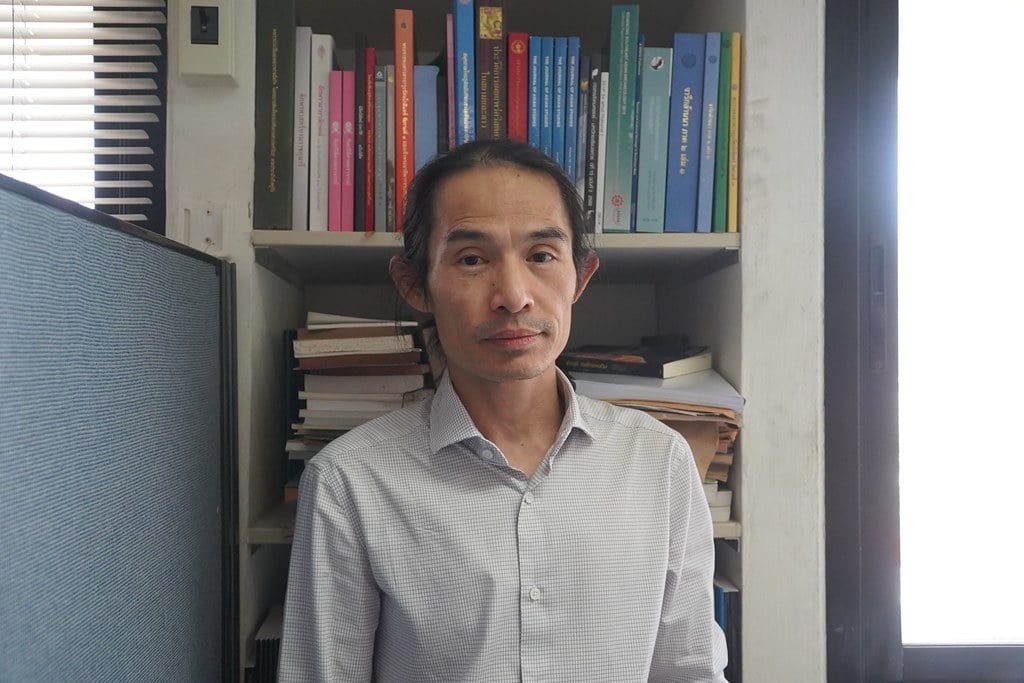
Assistant Professor Dr. Thibodi Baukamsee, a lecturer in the History Department, Faculty of Arts, Chulalongkorn University
It is believed that this claim is based on different historical foundations. The claim of provinces in Thailand relies on political and cultural authority, stating that they once had political and cultural power over areas in Thailand, which they calculated to be 36 provinces. In the case of Vietnam, there were communities and Khmer people residing there, as well as a significant Khmer political and cultural influence. But in the case of Thailand, there is no issue of the Khmer people living there.
As for Laos, he does not see which provinces they are claiming, but it was found that there were articles from over 100 years ago. Thereafter, it discussed the political influence of Cambodia during the reign of King Jayavarman VII, or during the 12th century, when Khmer influence extended up to Vientiane, as evidenced by records written by French academics that were indeed found. However, once found, can it be said that Khmer political power over that area was strong, or was it merely that the people there adopted Khmer culture, which is still a topic of debate. However, if one were to claim whether Khmer culture is present in Laos, the answer would be that temples (prasat) and religious icons are indeed found there.
However, if one were to claim that 36 provinces of Thailand belonged to Cambodia in the past, they would likely argue that there is no solid historical evidence to support this assertion.



